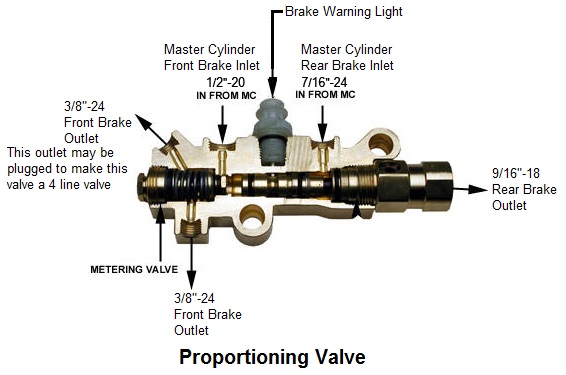
The proportioning valve also called the combination valve is located in the disc braking system. The proportioning valve also called the combination valve is located in the disc braking system.

A metering system within the valve comprised of a small and large valve and a spring govern the pressure between the front and rear brakes during sudden and emergency brake application.
Proportioning valve how it works. The proportioning valve typically connects the master cylinder to the rest of the braking system but sometimes it is independent of the cylinder. This valve is. Brake proportioning valves are the parts of a vehicles brake system that limit the amount of pressure reaching the rear brakes which helps to prevent rear wheel.
The proportioning valves are found on vehicles with front disc rear drum brake systems. They keep the rear brakes from locking up during. A Proportioning valve is required on vehicles that have disc brakes on the front wheels and drum brakes on the rear wheels.
Disc brake pads are normally in contact with. The proportioning valve only lets a certain portion of the pressure through to the rear wheels so that the front wheels apply more braking force. If the proportioning.
The proportioning valve only lets a certain portion of the pressure through to the rear wheels so that the front wheels apply more braking force. If the proportioning. Proportional valves restrict flow to and from an actuator.
They work best with a pressure-compensated pump in a closed-center circuit. An accumulator in the circuit. The proportioning valve also called the combination valve is located in the disc braking system.
It is responsible for controlling the braking pressure between the. Most adjustable brake proportioning valves are very simple devices designed to fit between the master cylinder and the rear brake line. The valve offers a range of.
The brake proportioning valve is a metering device that equalizes the pressure between the front and rear brakes. The valve stops the flow or pressure of brake fluid to. The Proportioning Valve part of the Combination Valve seen above and labeled as A is used to control the rear brakes.
What the Proportioning Valve does and when it actually works is one of the biggest misunderstandings in a Combination Valve. Vehicles with front disc and rear drum brakes have proportioning valves located on the brake line between the front and rear brakes. A metering system within the valve comprised of a small and large valve and a spring govern the pressure between the front and rear brakes during sudden and emergency brake application.
Locate the brake proportioning valve near the rear brake line. It will have one or two buttons located on it. Push the reset button located on the valve with your fingers which will reset it so the valve is working properly again.
The load sensing proportioning valve is located in the brake system for the rear wheels. It functions to control the brake fluid pressure from the master cylinder in response to the vehicle load and prevents early locking of the rear wheels. This provides directional stability under hard braking.
Click to see full answer. This video gives you an inside look at the combination valve. From its functions to bleeding tool use we explain its use and importance.
The technological solution to these more complex circuits has been the development of proportional valves. These revolutionary valves allow infinite positioning of spools thus providing infinitely adjustable flow volumes. Either stroke-controlled or force-controlled solenoids are used to achieve the infinite positioning of spools.
Heres a closer view of just the proportioning valve segment of the XJ valve. The upper vertical passage to the left is a full-pressure by-pass for the rear brakes in case the fronts fail. Under normal conditions the shuttle valve blocks it off as shown.